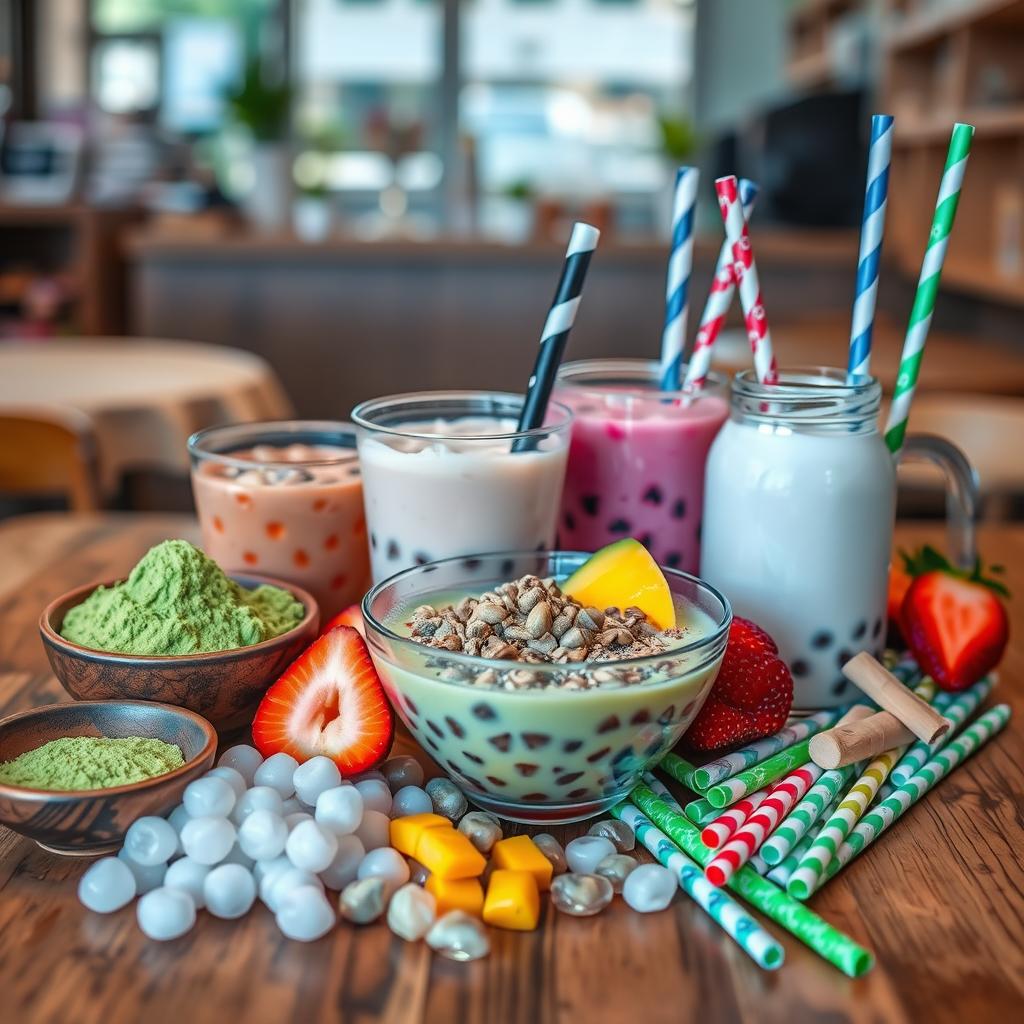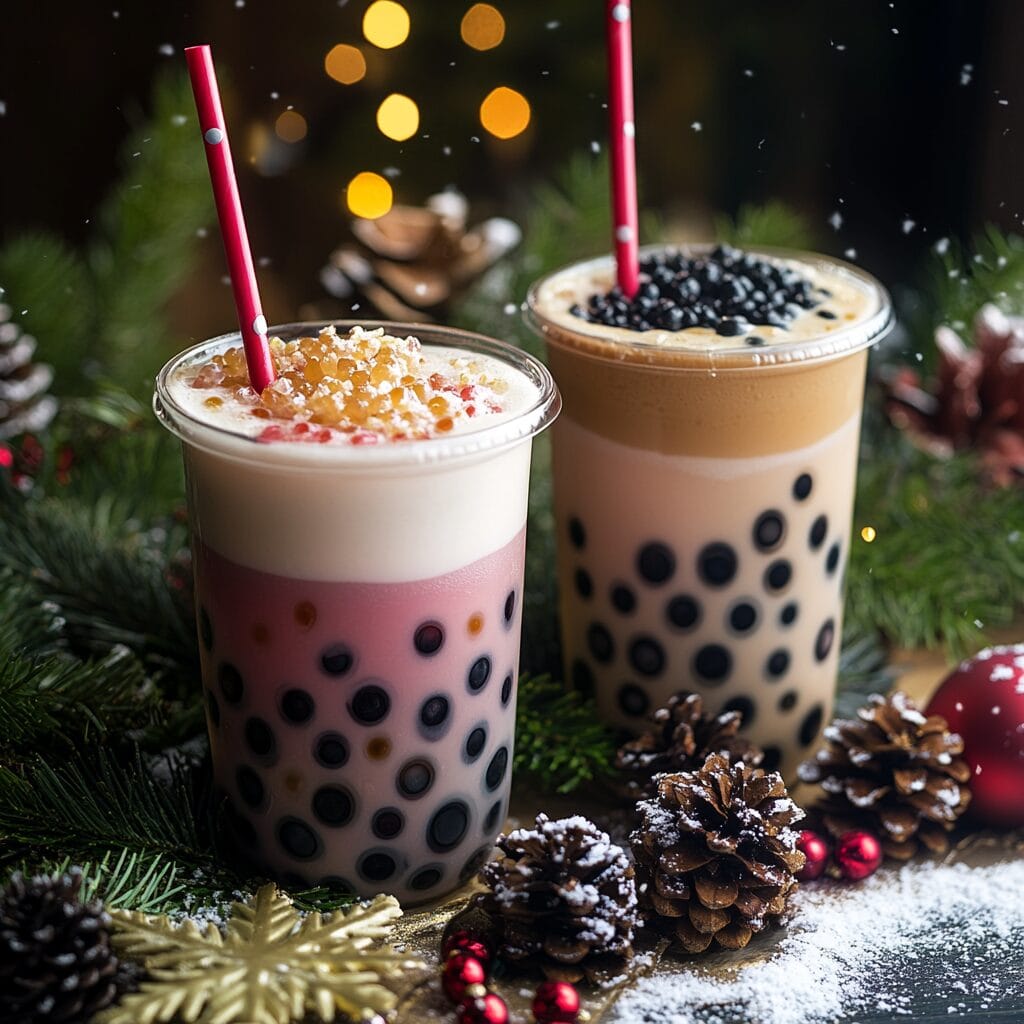I remember my first sip of bubble tea. It was a mix of smooth tea, chewy tapioca pearls, and vibrant flavors. It was love at first taste. This drink has become a global hit, blending cultures and flavors.
In this guide, we’ll explore what makes boba special. We’ll look at tapioca pearls, tea bases, and flavors. You’ll see the art and science in every sip of bubble tea.

Key Takeaways
- Discover the core components that make up boba, including tapioca pearls, tea bases, and various flavor profiles.
- Understand the evolution of bubble tea culture and its global popularity.
- Explore the science behind the unique texture and appearance of tapioca pearls.
- Learn about the different traditional and modern boba ingredients used in contemporary bubble tea recipes.
- Gain insights into the nutritional composition and potential health considerations of boba tea.
Understanding Bob Tea: A Brief Introduction
Boba tea, also known as bubble tea, has become a hit around the world. It started in Taiwan and now is loved everywhere. This drink has not only pleased our taste buds but also created a unique culture.
The Global Phenomenon of Bubble Tea
The story of boba tea began in the 1980s in Taiwan. It quickly grew into a favorite drink globally. Today, you can find boba shops in big cities everywhere. People from all over love these colorful drinks.
Evolution of Bob Culture
The boba tea culture has changed a lot over time. It’s no longer just a special drink but a big part of city life. Young people especially love it for its fun flavors and cool looks.

“Boba tea has become more than just a drink; it’s a cultural icon that brings people together, sparking conversations and fostering a sense of community.”
The boba craze keeps growing, changing how we enjoy drinks and socialize. From its start in Taiwan to its global fame, boba tea’s story is inspiring.
What Is Boba Made Of: Basic Ingredients Explained
If you love boba tea, you know the chewy tapioca pearls are key. But have you thought about what makes those boba tea pearls so special? Let’s explore the basic ingredients that make bubble tea so beloved.
Tapioca Pearls: The Heart of Boba
The heart of bob tea is the tapioca pearls, or “boba.” These small balls come from cassava root starch, a plant from South America. The starch is turned into dough, shaped into pearls, and cooked until they’re chewy and soft.
Tea: The Liquid Base
No bubble tea is complete without tea. Bob tea uses black, green, or oolong tea. This tea gives the drink its flavor.
Sweeteners: Adding the Finishing Touch
Sweeteners like sugar, honey, or syrup are added to balance the taste. How sweet it is depends on who’s drinking it, making bob tea sweet to different tastes.
Milk and Non-Dairy Options
Bob tea often includes milk or non-dairy alternatives like almond, soy, or oat milk. These add a creamy texture and richness.
With tapioca pearls, tea, sweeteners, and milk, boba tea comes to life. It offers a refreshing and delightful experience for everyone.

“Boba tea is more than just a drink – it’s a cultural phenomenon that has captivated taste buds around the world.”
The Science Behind Tapioca Pearls
Boba balls, or tapioca pearls, are the chewy heart of bubble tea. Ever wondered what they’re made of and how they’re made? Let’s explore the science behind these boba balls.
Chemical Composition of Tapioca Starch
The main part of boba balls is tapioca starch. It comes from the cassava root and is full of carbs. This starch is mostly amylose and amylopectin, which make the pearls chewy. The mix of these two is key to the boba balls‘ texture.
Processing Methods for Boba Pearls
Making the perfect boba balls is a detailed process. First, tapioca starch is mixed with water and sometimes color or flavor. This mix turns into a dough. Then, it’s shaped into long strands and cut into small balls.
These balls are steamed or boiled to make them chewy. This step is what keeps them soft and fun to eat.
Color and Texture Development
The look and feel of bob balls can change a lot. The cooking method can make them look clear or dark brown. The mix of amylose and amylopectin also affects their texture.
This mix makes each sip of bubble tea special. It’s a mix of science and art in every bite.
“Boba pearls are a fascinating blend of science and culinary artistry, with their unique chemical composition and intricate processing methods.”
Whether you love bob or just find it interesting, learning about bob balls makes you appreciate bubble tea more. It’s a fun journey into the science of these tasty treats.
Traditional vs Modern Boba Ingredients
The world of bob, or bubble tea, has changed a lot over time. Traditional recipes now mix with new flavors and ingredients. This change makes bob appealing to people all over the world.
Originally, bob was just tapioca pearls, tea, and sweetened condensed milk. This mix started the bubble tea craze. But, as bob became popular everywhere, chefs started adding new flavors. This made bob more exciting and varied.
Embracing Innovation
Now, bob comes in many flavors, from classic milk tea to fruit-infused and coffee-based drinks. Even some bob has alcohol. These new flavors attract more people and meet changing tastes.
| Traditional Boba Ingredients | Modern Boba Ingredients |
|---|---|
| Tapioca pearls Black tea Sweetened condensed milk | Tapioca pearls Fruit purees and juices Specialty teas (green, oolong, matcha) Non-dairy milk alternatives (almond, soy, oat) Boba-infused alcoholic beverages |
Some people still love the old boba flavors. But, new ingredients have made boba even more exciting. Now, you can find everything from fruity drinks to coffee-based boba. It’s a chance for chefs to be creative and for people to express themselves.
The bob craze is still growing, and it’s all about finding the right mix of old and new. This balance will keep making boba a favorite drink for many.
Essential Components of Bubble Tea Base
Bubble tea, also known as bob tea, is loved by many around the world. Its base is key, made of ingredients that give it flavor and texture. Let’s explore what makes up the perfect bubble tea pearls.
Tea Varieties Used in Boba
The tea in bubble tea can be different, with many choices. Black tea is common, offering a strong taste. But, you can also find green tea, oolong tea, and herbal infusions. Each tea adds its own scent, taste, and caffeine level, letting you choose what you like.
Milk and Non-Dairy Alternatives
Milk is crucial for the bubble tea base, making it creamy. Dairy milk is popular, but there are also non-dairy options. Almond milk, soy milk, and oat milk are favorites for their taste and health benefits. They’re great for those who can’t have dairy or follow a vegan diet, making bubble tea more fun for everyone.
“The beauty of bubble tea lies in its endless possibilities. From the tea selection to the milk options, the combinations are truly limitless, allowing for endless experimentation and personalization.”
Knowing what makes up the bubble tea base opens up a world of possibilities. You can make your own special boba recipe to enjoy.
Popular Boba Flavors and Additives
The world of boba, or bubble tea, is full of life and change. It draws in tea lovers with its many flavors and ingredients. You can choose from classic tastes or try new ones, making your boba experience unique.
The core of boba’s taste comes from the boba flavors. Tapioca pearls, the main part of bubble tea, can taste like brown sugar or taro. You can even find matcha or alcoholic flavors.
Beyond the tapioca pearls, boba has many boba ingredients. Syrups, jellies, and puddings mix well with the tea. They add layers of taste and texture that excite your senses.
| Popular Boba Flavors | Boba Additives |
|---|---|
| Brown Sugar Taro Matcha Chocolate Strawberry | Fruit Syrups Jellies Puddings Aloe Vera Grass Jelly |
Whether you like the traditional milk tea or something new, boba has it all. It offers a taste adventure like no other. Start exploring the vibrant boba flavors and boba ingredients today.
“The diversity of boba flavors and additives is what makes this beverage so captivating and endlessly customizable.”
Making Boba Pearls at Home: Step-by-Step Guide
Making boba pearls at home is fun and rewarding. It’s great for boba tea lovers or those who want to try new flavors. Here’s how to make perfect boba balls at home.
Required Tools and Equipment
You’ll need some basic kitchen items to start. Make sure you have:
- Tapioca flour or starch
- Water
- Saucepan or pot
- Wooden spoon or spatula
- Slotted spoon
- Airtight container for storage
Cooking and Storage Tips
Now, let’s get to cooking:
- Boil water in a saucepan over medium heat.
- Add tapioca flour slowly, stirring well to avoid lumps.
- Cook and stir until it’s thick and gummy, about 5-7 minutes.
- Use a slotted spoon to move the boba to cold water to cool.
- Drain the boba and mix with a bit of oil to stop sticking.
- Keep the boba in an airtight container in the fridge for up to 5 days.
By following these steps, you can make tasty boba balls for your boba recipe. Try different flavors and toppings to make your bubble tea special.
Nutritional Composition of Boba Tea
Is boba tea healthy or unhealthy? The answer depends on its nutritional content. Boba tea, a favorite in Asia, has become popular worldwide. But, its health effects are still debated.
Many worry about boba tea’s calories and sugar. A typical cup has 200 to 450 calories. Most of these calories come from sugar, with 20 to 50 grams per serving.
| Nutrient | Amount per Serving |
|---|---|
| Calories | 200-450 |
| Sugar | 20-50 grams |
| Carbohydrates | 40-80 grams |
| Protein | 2-4 grams |
| Fat | 3-10 grams |
The high sugar in boba tea worries many. It may lead to weight gain, diabetes, and other health problems. But, the nutritional value of boba tea can change a lot. It depends on the ingredients, portion size, and your diet.
Despite the sugar, bob tea has some good points. The tea base, like green or black tea, has antioxidants. These can help your heart and brain. The tapioca pearls also add carbs for energy.
So, how healthy is bob tea? It really depends on how you drink it. Drinking it in moderation is best. Think about your diet and health goals before enjoying boba tea.
Common Misconceptions About Boba Ingredients
Many people wonder what is bob made of and what’s in bob tea. There are lots of myths out there. Let’s clear up the confusion about food safety and the real deal about bob.
Debunking Boba Myths
Some think bob ingredients are unhealthy or unsafe. But that’s not true. Tapioca pearls, the main part of bob, come from cassava root. This is gluten-free and full of nutrients. When made right, bob is safe and fun to drink.
Another myth is that bob is new or just a trend. But bubble tea has been loved in Asia for years. It has a rich history and many flavors. Bob can be enjoyed in many ways, from classic milk tea to fruity drinks.
Understanding Food Safety
To keep what is bob made of safe, buy from trusted sources. Follow the right steps for handling and storing. Cook tapioca pearls well and keep them at the right temperature. Also, think about any food allergies when you drink bob tea.
| Boba Ingredient | Proper Handling | Storage Conditions |
|---|---|---|
| Tapioca Pearls | Cook thoroughly at high heat | Keep at room temperature in an airtight container |
| Tea | Steep properly using fresh, filtered water | Store in a cool, dark place in an airtight container |
| Milk/Non-dairy Alternatives | Use fresh, high-quality dairy or plant-based milk | Refrigerate and consume within expiration date |
| Syrups and Flavors | Ensure food-grade quality and follow manufacturer’s instructions | Refrigerate and use within recommended timeframe |
Knowing the truth about bob ingredients and following food safety tips lets you enjoy bob tea without worries. It’s a fun and unique drink experience.
Halal Status and Dietary Considerations
Bob tea is generally considered halal. This is because its main ingredients like tea, milk, and sweeteners come from halal sources. However, the tapioca pearls, or bob, might raise concerns for Muslim consumers.
Tapioca, the main part of bob pearls, comes from the cassava root. This is a plant-based ingredient that is halal-friendly. But, some makers might add non-halal stuff like gelatin from pork. To make sure your bob tea is halal, always check the label or ask the vendor about the ingredients and how they’re made.
Bob tea also fits different diets. Many places offer dairy-free and vegan options. They use non-dairy milks like almond, soy, or oat milk. There are also gluten-free bob pearls for those with gluten issues. By knowing your dietary needs, you can enjoy bob tea’s tasty flavors while sticking to your diet.
The Science Behind Tapioca Pearls
The unique texture of bob pearls comes from tapioca starch, rich in amylose and amylopectin. These compounds give the pearls their signature chewiness. For a deep dive into the science of food textures, read this exploration of culinary processes.
FAQ
What is boba made of?
Bob, also known as bubble tea pearls, is mainly tapioca starch. It includes tapioca pearls, tea, milk or dairy alternatives, and sweeteners like sugar or fruit syrups.
What are the basic ingredients in bubble tea?
Basic bubble tea has tapioca pearls, tea, and a sweetener or flavoring. You might also find milk or non-dairy alternatives, fruit purees or syrups, and toppings or mix-ins.
How are boba pearls made?
Pearls come from tapioca starch, from the cassava root. This starch is mixed with water and other ingredients. Then, it’s rolled into small balls and cooked to get their chewy texture.
What is the origin of bubble tea?
Bubble tea, or bob tea, started in Taiwan in the 1980s. It became popular in Taiwan and then spread globally, especially in urban areas.
What are the different flavors ?
Boba flavors range from fruit purees and syrups to teas and coffee. Favorites include brown sugar, taro, honeydew, strawberry, and classic milk tea.
Is boba tea halal?
Bob tea’s halal status depends on its ingredients. Traditional bob with black or green tea, tapioca pearls, and non-dairy milk is usually halal. But, some drinks might have non-halal ingredients like gelatin or alcohol-based flavorings. Always check the ingredients and source to ensure it’s halal.

